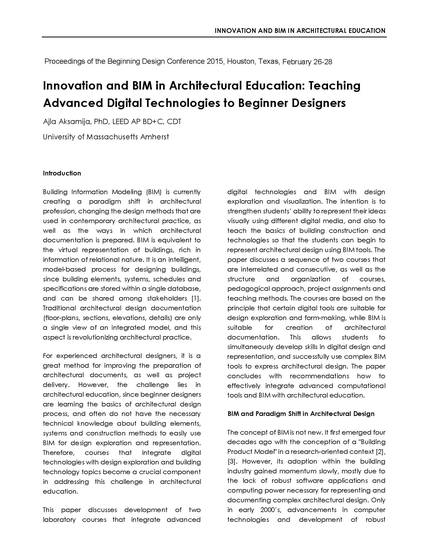
Article
Innovation and BIM in Architectural Education: Teaching Advanced Digital Technologies to Beginner Designers
Proceedings of the 31st National Conference on the Beginning Design Student 2015
(2015)
Abstract
Building Information Modeling (BIM) is currently creating a paradigm shift in architectural profession, changing the design methods that are used in contemporary architectural practice, as well as the ways in which architectural documentation is prepared. BIM is equivalent to the virtual representation of buildings, rich in information of relational nature. It is an intelligent, model-based process for designing buildings, since building elements, systems, schedules and specifications are stored within a single database, and can be shared among stakeholders. Traditional architectural design documentation (floorplans, sections, elevations, details) are only a single view of an integrated model, and this aspect is revolutionizing architectural practice.
For experienced architectural designers, it is a great method for improving the preparation of architectural documents, as well as project delivery. However, the challenge lies in architectural education, since beginner designers are learning the basics of architectural design process, and often do not have the necessary technical knowledge about building elements, systems and construction methods to easily use BIM for design exploration and representation. Therefore, courses that integrate digital technologies with design exploration and building technology topics become a crucial component in addressing this challenge in architectural education.
This paper discusses development of two laboratory courses that integrate advanced digital technologies and BIM with design exploration and visualization. The intention is to strengthen students’ ability to represent their ideas visually using different digital media, and also to teach the basics of building construction and technologies so that the students can begin to represent architectural design using BIM tools. The paper discusses a sequence of two courses that are interrelated and consecutive, as well as the structure and organization of courses, pedagogical approach, project assignments and teaching methods. The courses are based on the principle that certain digital tools are suitable for design exploration and form-making, while BIM is suitable for creation of architectural documentation. This allows students to simultaneously develop skills in digital design and representation, and successfully use complex BIM tools to express architectural design. The paper concludes with recommendations how to effectively integrate advanced computational tools and BIM with architectural education.
Keywords
- BIM,
- architectural education,
- innovation,
- digital technologies,
- design
Disciplines
Publication Date
2015
Citation Information
Ajla Aksamija. "Innovation and BIM in Architectural Education: Teaching Advanced Digital Technologies to Beginner Designers" Proceedings of the 31st National Conference on the Beginning Design Student 2015 (2015) Available at: http://works.bepress.com/ajla_aksamija/86/
